Nine years after the publication of HBO’s groundbreaking war epic, Band of Brothers, creators Steven Spielberg and Tom Hanks forged a companion piece to their previous show. Seeking to explore a miniseries covering the stories of American Marines in the Pacific, the pair set out to create yet another emotionally intense, foreboding, yet commemorative film series to honor the sacrifices paid by past Americans who served their country.
Yet, what would soon be called The Pacific took a different route in its storytelling and design than its predecessor. Just as the real combat experienced by the American marines, sailors, and soldiers in the Pacific differed greatly from the more “conventional” warfare in the European Theater of Operations, Band of Brothers and The Pacific are, at their foundations, two very different shows.
This article is the second in a planned trilogy of articles covering three of what I have termed as “HBO’s War Epics,” series covering American military history that I found to be not only culturally significant as reflections of America’s history and culture, but also personally significant to this reporter.
***Warning: The following article contains descriptions and images of violence and war crimes.
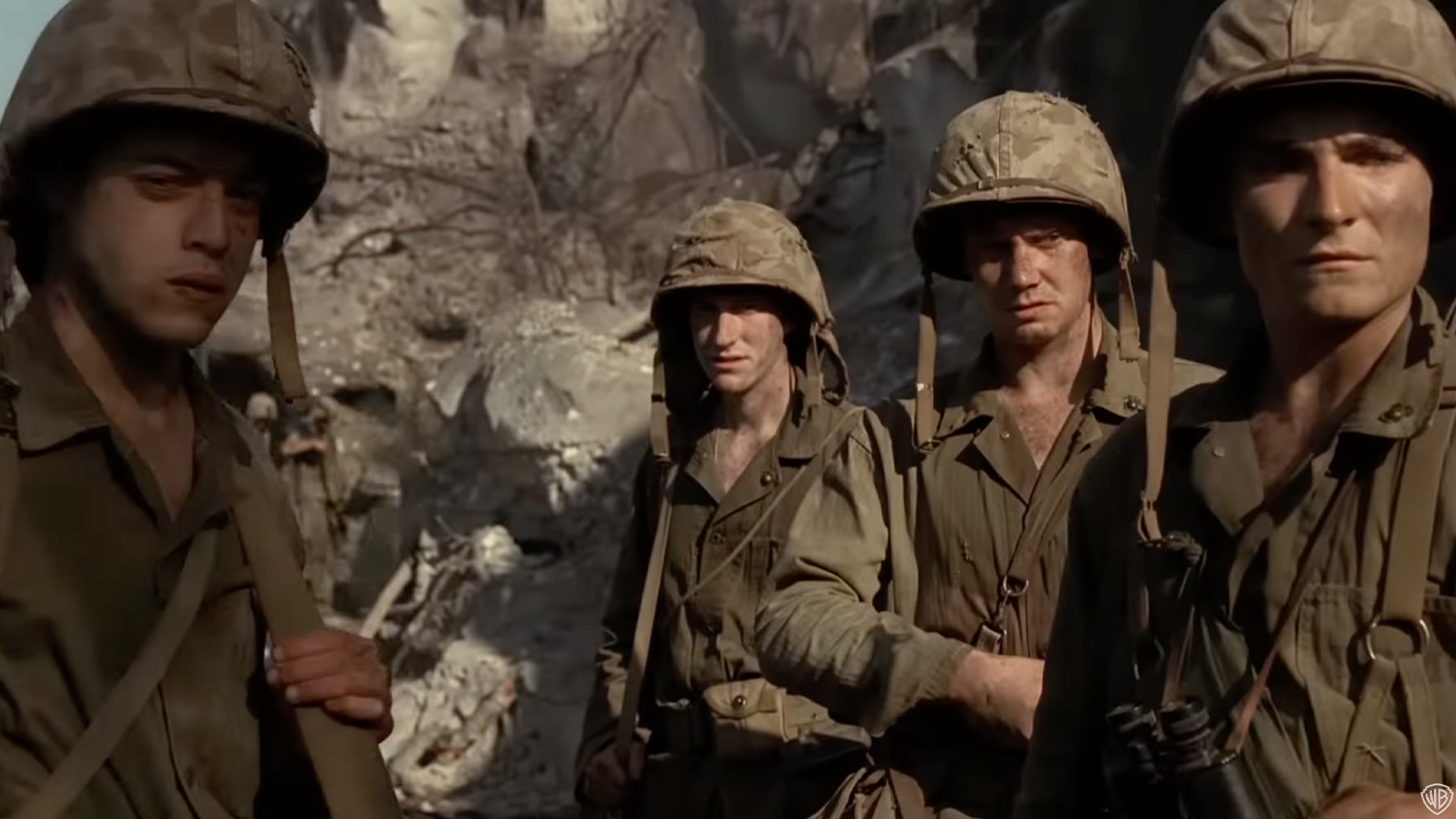
Background: Development and Aspirations
Band of Brothers was a dazzling success for HBO, and as I covered in my previous article on HBO’s war epics, it came at a crucial time for America, as terrorist attacks gripped the globe in 2001, the story of a hardscrabble company of American paratroopers achieving great feats of arms and enduring great suffering to achieve final victory found extreme popularity amongst the American population.
Spielberg and Hanks, read the memoirs of several Marines – namely With the Old Breed by Eugene Sledge, A Helmet for My Pillow by Robert Leckie, and Red Blood, Black Sand by Chuck Tatum. All three Marines served at the most iconic battlefields of the Corps history in the Pacific – Guadalcanal, Peleliu, Iwo Jima, and Okinawa. Both directors agreed to start a new series based off of these memoirs.
Spielberg, in an interview with magazine Collider, said the following about his aims for the series:
“It wasn’t that I was trying to break the mold of the old war movie approach, visually, but I was simply trying to validate all of this testimony that had been communicated to us, based on the young men that lived and survived that battle. I didn’t know it was going to establish a look for war movies, but it was certainly what I thought was right for that particular story.”
Tom Hanks would later recall that upon reading Sledge and Leckie’s memoirs, they wondered how to piece the stories together. After all, the two Marines were from separate regiments – the 1st and 5th Marines respectively – and that didn’t even account for Tatum, who was a member of the 5th Marine Division which never even participated in the same campaigns as Sledge and Leckie.

But, Hanks realized that a long time friend of Sledge, Sidney Phillips, was a member of Robert Leckie’s rifle company. Hanks and Spielberg had their way in, and they could cover the stories of Leckie and Sledge while being connected, even if the two rarely connected face to face with each other (more on that later). For Tatum, he was sidelined as a side character in favor of a prominent character in his memoir – John Basilone, a recipient of the Medal of Honor in the Battle for Guadalcanal.
The three characters selected for the show coverage were now set. Basilone (played by Jon Seda), Leckie (James Badge Dale), and Sledge (Joseph Mazzello) would be covered in a 10-part miniseries. Other actors include Rami Malek, Ashton Holmes, Josh Helman, Martin McCann, and Claire van der Boom.
The Characters
It would be easiest to cover The Pacific through the lens of its three main characters. Whereas Band of Brothers attempted to cover a new character’s perspective each episode, with Major Winters holding his place as the main narrator, The Pacific eschewed this in favor of a deeper exploration of the psyche of our three heroes.
Each episode is often shared between all three characters and their respective units, so in that respect it is very different than Band of Brothers. Additionally, each episode lacks the veteran narration that I cited in my previous article as being so immersive for Band of Brothers. This is because by 2010, most veterans of WW2, especially Marine combat veterans, were lost, with only Chuck Tatum still alive.
Thus, the narration of veterans was replaced by a map of the Pacific theater that would slowly zoom in on each location being focused in on. Often times while watching this, I would reflect on how obscure these island chains were. Where even are these places, I would often ask myself. That remains the point however – to show that the Marines were doing battle with the Japanese on remote stretches of sand in the Pacific, necessary to claw back the enemy so the Americans could eventually threaten the Japanese home islands with invasion.

The Pacific foregoes the culturally familiar settings of England and France with the exotic tropical jungle of the Pacific. Like in a Thin Red Line, the setting is often placed on full display to show case the stunning environments the Marines find themselves in. But said environments also can turn into threats and traps for the Marines, as seen throughout the series.
The following sections will be devoted to each of the three characters, and I will discuss various aspects of the plot and characters, so spoiler warning!
Robert Leckie
Robert was born December 18th, 1920 in Philadelphia but spent much of his life in New Jersey. Following the Japanese attack at Pearl Harbor, Leckie enlisted in the U.S Marine Corps. The opening shot of the series is Leckie entering a cathedral to pray, while encountering Vera, a girl who lives across the street whom Leckie promises to write to.
Leckie begins his story as a well educated (having an extremely deep knowledge of literature, poetry, and fiction) man and idealistic. He believes in the mission laid out before him, and earns his baptism of fire in the Guadalcanal Campaign. Its here that Leckie realizes that life in the Marines isn’t the straight up adventure he thought it would be – the Marines are surrounded on the island as the U.S Navy is defeated at sea by the Japanese, and Leckie struggles to comprehend the dual majesty and danger the wild jungle poses to him and his friends.

By Episode Two, Leckie and the other Marines are a hardscrabble group of survivors who appear as if they’ve aged five years in the span of a few weeks. The Marines, continuously deprived of supplies and under constant attack by the Japanese, resort to foraging and stealing for supplies. Leckie and the other Marines see the unconventional brutality of the Japanese, who are willing to kill and mutilate American prisoners as well as feign surrender to kill Navy corpsmen (medical personnel attached to Marine units).
His previous innocence shattered, Leckie instinctively grows close in bonds to his friends, Lew ‘Chuckler’ Juergens, Bill Smith, Sidney Phillips, and Wilbur ‘Runner’ Conley. The comradery of the show’s characters is on par with Band of Brothers, although the split focus on three separate characters does undercut its effectiveness at times.
Leckie’s future adventures while on leave in Australia, or the unconventionality of the campaign on New Gloucester, and the horrors of Peleliu sap his mental fortitude and further erode his past convictions. Leckie loses his faith in himself, the leadership of the Marine Corps, and even in love, and only can rely on the courage and brotherhood he finds in his fellow Marines. But on Peleliu, as numerous friends are killed or wounded, Leckie breaks. When he is finally wounded and put aboard a hospital ship, Leckie spurts blood out of his mouth and begins to cry. He has finally been mentally broken and cannot continue any longer.
“Leckie loses his faith in himself, the leadership of the Marine Corps, and even in love.”
The story of Robert Leckie stood out to me in that it represents the absolute limits the human body can endure for the sake of a broader mission or aspiration. Leckie could, as the old saying goes, “only fight so many more wars.” He’s my favorite character in The Pacific, because of his wit, charm, and also relatable fall from grace. He simply, as a character on the show Dr. Grant put it, “just needed some rest.”

Eugene Sledge
Eugene Sledge entered the world on November 4th, 1923 in Mobile Alabama to a wealthy family who encouraged him to enter college. Undeterred, Sledge sought to enlist after the attack at Pearl Harbor but was sidelined by a heart murmur. By 1942, it has subsided to the point where he could enlist in the Marine Corps by December of that year. Sledge thus, out of all three main characters, was not only the youngest Marine, but also the one who enlisted last.
Sledge’s character, first shown in Episode One, remains even more optimistic about his future military endeavors than Leckie. He writes letters to his friend Sydney lamenting his inability to enlist because of the heart murmurs, but after that has been done, he eagerly awaits the great adventure reportedly awaiting him. Sledge is assigned as a mortarman in the 5th Marine Regiment, a part of the 1st Marine Division that Robert Leckie also finds himself in. Sledge and Leckie likely never met, even with the shared connection through Sydney Phillips, but the show puts them together on the eve of the invasion of Peleliu in 1944.
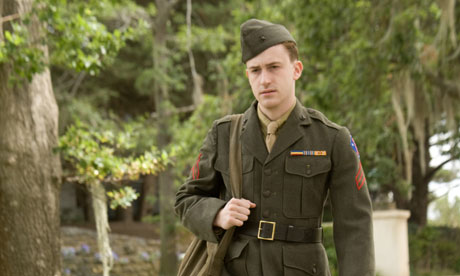
Leckie’s pessimism towards the future dampens Sledge’s untampered naivety, and its here we learn that Leckie has lost his faith in God after the horrors he witnessed and the heartbreak endured the past two years. Sledge, by contrast, holds firm in his faith in God and excitedly walks around the tent as he describes the stories of war he hears from Europe. Ironically, the coming battle at Peleliu would be not only Sledge’s first trial of fire, but also Leckie’s last.
The landing scene at Peleliu is not only astounding to watch in all its horror, but was a technological marvel to produce. For every second of film, thousands of dollars were spent to coordinate the real and computer effects of a full scale Marine amphibious landing on a remote Pacific island. For the intensity of combat scenes, The Pacific does not disappoint.
Spielberg had this to say about creating combat scenes for his show:
“In the re-creation of combat situations, and this is coming from a director who’s never been in one, being mindful of what these veterans have actually gone through, you find that the biggest concern is that you don’t look at war as a geopolitical endeavor. You look at war as something that is putting your best friend in jeopardy. You are responsible for the person in front of you and the person behind you, and the person to the left of you and the person to the right of you. Those are the small pods that will inadvertently create a hero, but that is someone else’s observation, not the observation of those kids in the foxholes.”
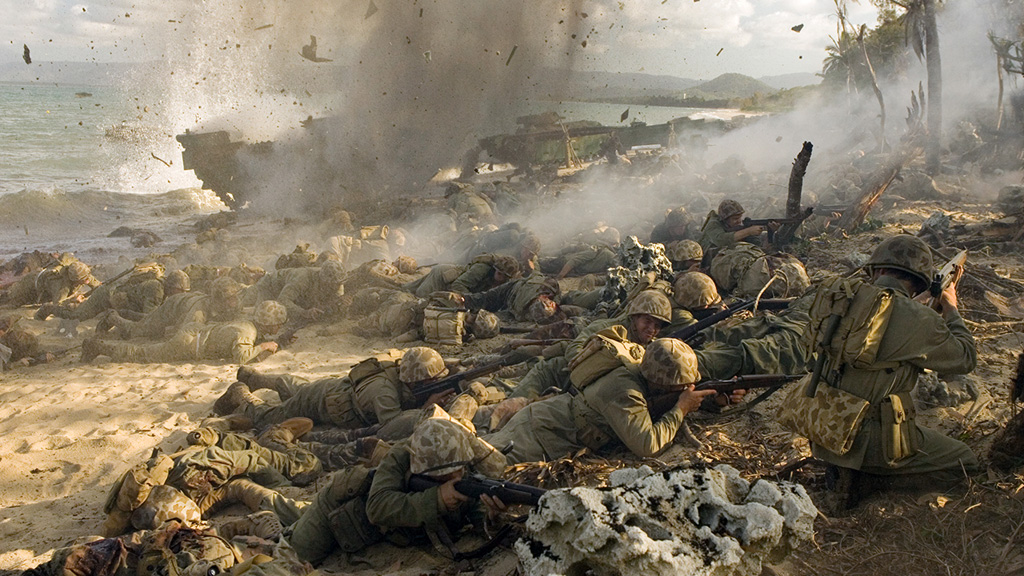
“you don’t look at war as a geopolitical endeavor. You look at war as something that is putting your best friend in jeopardy.”
Sledge would go on to see further combat in Okinawa which was one of the most bloody in the Pacific theater. Japanese forces – numbering nearly 100,000 – entrenched themselves on the island. Being technically a part of Japanese territory, the Japanese fought fiercely for control of every inch and utilized the civilian population against the Americans. Told by Japanese troops that the American Marines and soldiers would slaughter, rape, and torture them, thousands of Okinawan civilians either committed suicide, or attacked American soldiers with makeshift spears and hand grenades.
After two months and three weeks of fighting, American forces emerged victorious, only after suffering nearly 50,000 killed and wounded. Japanese forces endured nearly 110,000 casualties, including nearly 93,000 killed. The civilian population may have endured losses of nearly 150,000, with many slaughtered by Japanese forces in the waning days of the battle as the Americans broke through the Japanese lines.
Eugene Sledge would witness many of these atrocities first hand, as well as the barbaric treatment of American prisoners of war by Japanese soldiers, which included grotesque mutilation.
But American Marines, increasingly desensitized to the conflict, also began to show little mercy towards the Japanese. Japanese prisoners, under suspicion of being suicide bombers, were almost always executed on the spot. Dead Japanese soldiers had their teeth severed by Marines scouring for gold teeth. “Gold goes for 32 an ounce, why not try striking,” says one of Sledge’s fellow Marines.
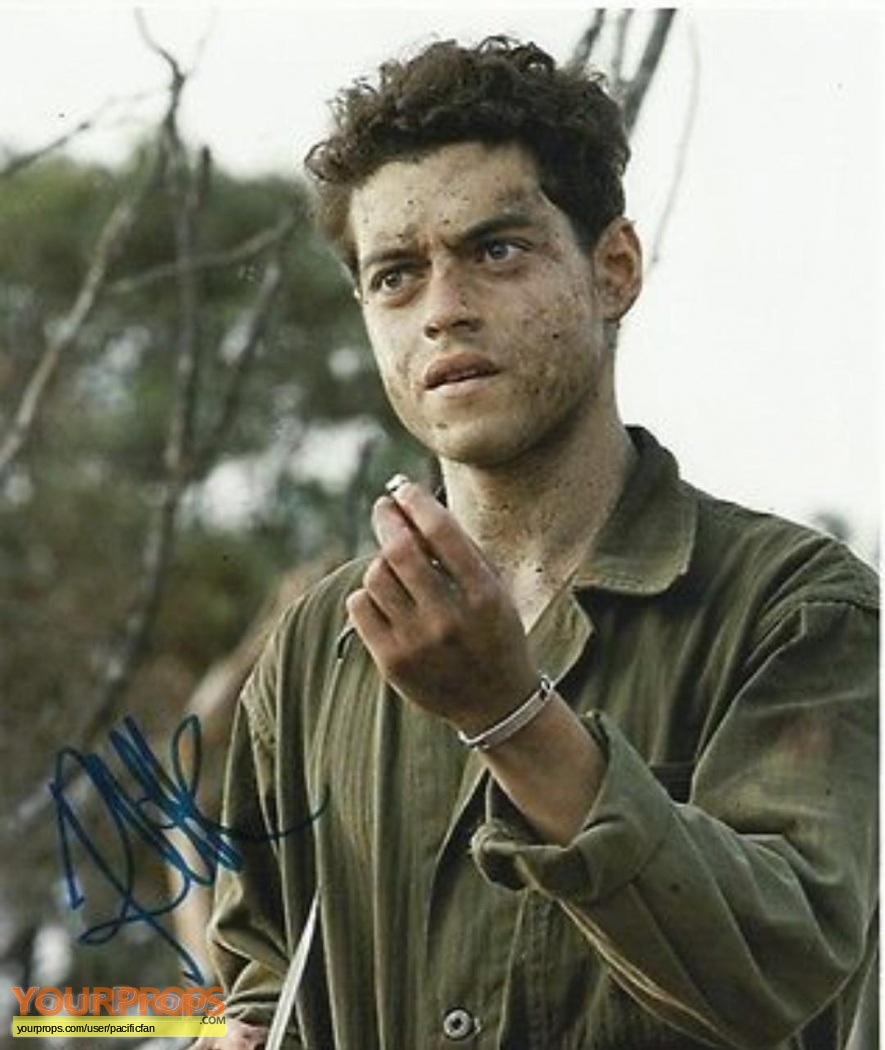
The mental exhaustion felt by Leckie was passed on to Sledge. In one particularly disturbing scene, Sledge saw a Marine throw pebbles at a dead Japanese soldier whose top head had been blown off, with the bottom of the skull exposed revealing a soppy liquid of brain matter and blood. Each pebble, according to Sledge, made a distinct plop sound at it went into the skull. Undisturbed, Sledge went to sleep.
By the time the war has ended, Sledge returns home but struggles with the horrors of what he has witnessed. While Band of Brothers rarely covered the emotional trauma felt by the soldiers, The Pacific does not pull any punches. Marines like Sledge experience night terrors, panic attacks, and experience bouts of depression as a reaction to the inhuman trials they had to undergo.
Executive producer for the show Gary Goetzman said the following about the depiction of the war’s effects on the Marines: “It was very important for us to show how this war affected these men, during the war, after the war, [which] really was something we didn’t get into in ‘Band of Brothers.’”
“It was very important for us to show this war affected these men after the war, [which] really was something we didn’t get into in ‘Band of brothers.'”
John Basilone
Born in Buffalo New York on November 4th, 1916, John Basilone grew up in a large Italian-American family. Like Leckie, he would later grow up in New Jersey and enlisted in the US Army in 1934, and served 3 years in the Philippines. In 1940, he enlisted in the Marine Corps and quickly became a NCO (non-commissioned officer) due to his leadership potential.
As the show portrays, the Marines consider their NCO corps to be the backbone of their combat effectiveness. Colonel Lewis ‘Chesty’ Puller, who commanded Sergeant John Basilone’s unit of the 7th Marine Regiment, said it best in a speech to his regiment’s NCOs:
“The Japanese are not expecting the United States Marine Corps… we will do battle with the Japanese on tiny specks of dirt we have never heard of. You, non-commissioned officers, are the sinew and the muscle of the corps. The orders come from the brass and you get them done. [Although] the strategy will have been done by others, the victory will have been won by you, the NCOs, with the chevrons on your sleeves, the instincts in your guts, and the blood on your boots.”
“the victory will have been won by you, the NCOs, with the chevrons on your sleeves, the instincts in your guts, and the blood on your boots.”
Basilone, like Leckie, would first see combat in Guadalcanal. On October 24th, 1942, Basilone’s unit would be attacked by hundreds of Japanese soldiers. The Marines were stretched thin and required constant replenishment of ammunition as the machine gunners constantly emptied their magazines into the inexorable Japanese wave assaults. Throughout the entire day, Basilone’s unit of Marines were whittled down to just himself and two other men.

Nearly surrounded, Basilone ran through the jungle with nothing but a pistol to retrieve ammunition for his machine gun emplacement. On the second day, the machine gun ammunition ran completely out, and Sergeant Basilone could no longer retrieve new ammunition as the Japanese had infiltrated their rear positions.
Now armed with nothing but a pistol and a machete, Basilone fended off wave after wave of Japanese infantry. As one fellow Marine put it, “Basilone had a machine gun on the go for three days and nights without sleep, rest, or food. He was in a good emplacement, and causing the Japanese lots of trouble, not only firing his machine gun, but also using his pistol.”
Basilone would be recommended for the Medal of Honor. While Leckie and Sledge fought throughout Peleliu and New Gloucester, Basilone was sent home to raise money for war bonds, essentially loans by citizens to the government to help fund the war effort. But Basilone yearned for a return to combat, as he finds home life to be unsatisfying for him. Basilone’s own mental turmoil are not the same as Leckie’s or Sledge’s – he wants to return to combat, not escape it – but the stress he undergoes while at home reflects The Pacific’s determination to show the emotional effects of the war on the home front.
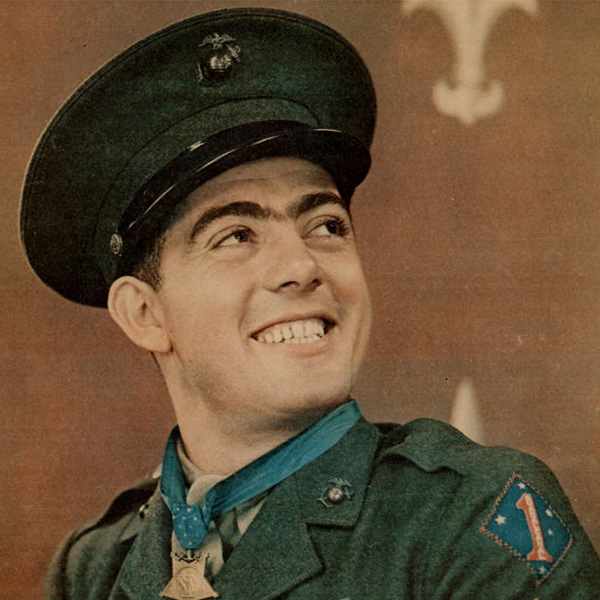
Conclusion
Falling in the footsteps of such a hit as Band of Brothers was a difficult task. But it was one that excellent directors and writers such as Spielberg, Hanks, Gary Goetzman and Bruce McKenna could pull off. The Pacific pulls the audience in a uniquely different way than its predecessor, far from the close knit comradery and happy endings of triumph, and towards the dark recesses of the human mind, scarred and torn apart by war. It shows a startingly realistic portrayal of individual disillusionment, towards the war, the leadership of the Corps, and towards each individual Marine.
The Pacific, in the words of writer Barry Garron, “[has] the idea to present the war from the vantage point of the Marines who deployed where they were told, rested when they could and then fought somewhere else.”
The lack of narration and repetitiveness of each campaign reinforces the often mundane aspects of warfare, the “rinse and repeat” that sees the individual enlisted personnel go through their own trials and tribulations to come out on top. The Pacific, therefore, in many places surpasses Band of Brothers. It does not pull any punches, and will deliver an emotionally raw experience to its viewers. I could not recommend this miniseries any more, and it truly earns its place as one of the best series HBO has ever produced.






